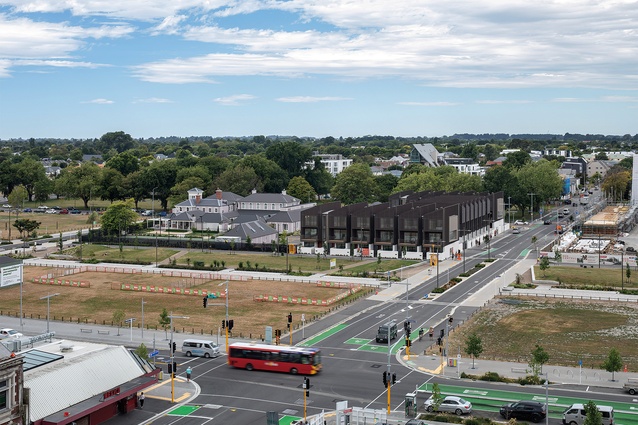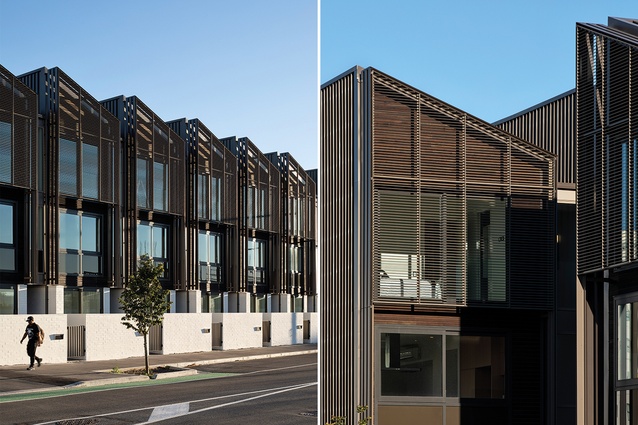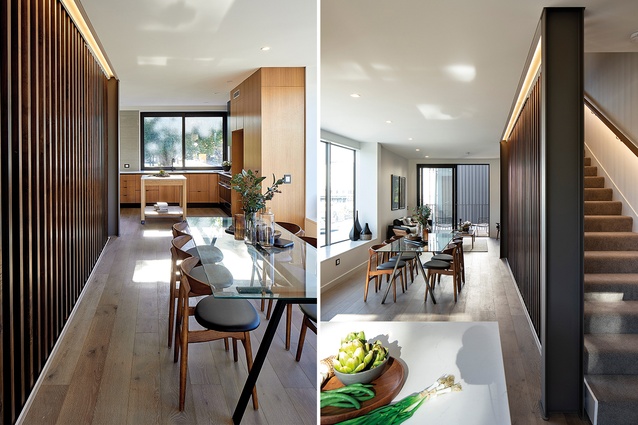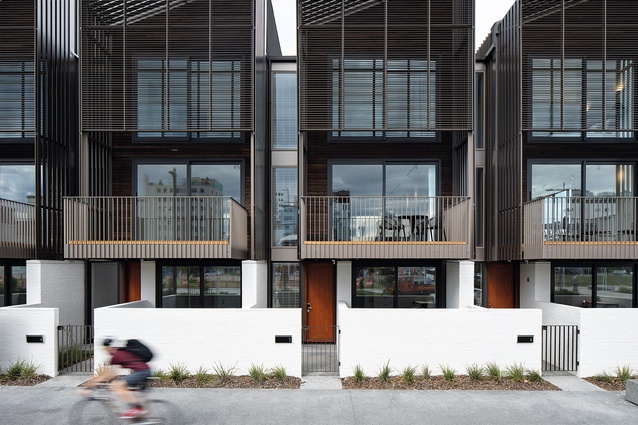Fit for pawns and queens: Latimer Terraces
Abigail Hurst explores Warren and Mahoney’s Latimer Terraces, the first of many chessboard moves to establish diverse central-city living in Christchurch’s East Frame.
The giant, unseen forces of the housing market are being played out in One Central, the inner-city housing development of Christchurch. This ambitious anchor project, delivered by Fletcher Living and commissioned by Crown entity Ōtākaro Limited, is a critical part of the Christchurch City Council’s plan to have 20,000 people living in the inner city by 2024.
One Central will provide more than 900 flats and townhouses and enable this much-needed change for the city. A chessboard-like strategy combining a diverse layout of various shapes and purposes with a game plan to attract equally diverse people and family units has been implemented to face the considerable challenges to this plan. With the first moves under way, its fate now sits in the hands of the public.
The new central-city living area of the ‘East Frame’ (now called One Central) was proposed by the Christchurch Central Recovery Plan (2012) after the 2010–2011 earthquakes.1 A competition ensued and the architectural component was eventually won by a DKO Architecture and Architectus collaboration, with a vision for three precincts and 15 distinctive neighbourhoods, creating diversity and central-city living for all. Following the competition, it was decided these neighbourhood lots would be designed by different local architects, creating a full chessboard of pieces, including space for the humble pawns.
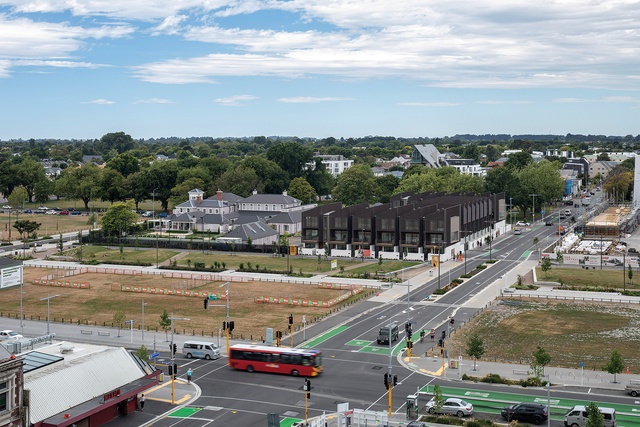
Although not intended to be the first piece completed, the Latimer Terraces by Warren and Mahoney comprising 20 terrace-style houses, were finished and on the market from July 2018. Conceived as individual objects with distinguishable edges, the three-storeyed terraced units appear as distinct entities within their rows. In an earlier design, the roofs faced different ways, rendering more individuality; however, the provision of solar panels led to the pitches all facing north. The result is a sawtooth roof silhouette interrupted by narrow, oblong entrances between units. Horizontal aluminium slatting thinly veils the top-most floor and brings an aesthetic continuity as well as an aspect of privacy to the elegant forms.
To the casual observer, the Latimer Terraces of One Central look like a gentrified (and expensive) terrace house set-up. Three rows of terraced houses are laid in a U-shape, with the open end facing north. The units are bordered west and east by Rauora (formerly Linear) Park and Latimer Square respectively, to the north by The Christchurch Club and to the south by Hereford Street.
The terraced houses have a sense of urban seclusion, with a primary outlook for the first-floor living spaces to trees and park. Inside, the landscaped courtyard has private access only. Although primarily car-centric, this courtyard has been thoughtfully considered with paving, cobbling, planting and simple white pergolas relieving the eye and breaking down scale. Provision for access to the neighbouring prestigious Christchurch Club has also been made – a cheeky gate is ready for any club member who buys one of these residences.
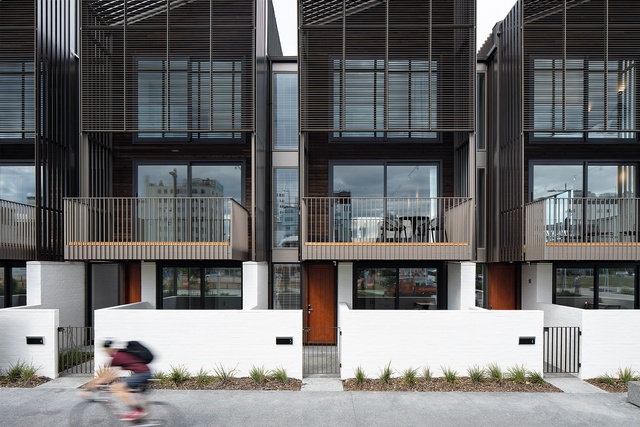
However, these townhouses need not be just for the rich. With house ownership out of reach for many, architect Richard McGowan suggests that, if we are no longer able to make housing affordable, perhaps we should be looking to make housing accessible through non-traditional strategies of house ownership. A close examination of the planning reveals surprising flexibility for multiple types of buyer. McGowan proposes that there might be four different strands to which the houses appeal: the traditional family, a semi-retired couple, two professional people who share ownership of the house but don’t share a bed, and a professional working couple that does (share a bed).
For this reason, the two bedrooms on the top floor are not a master and a secondary room, but are equivalent, articulating a co-ownership possibility.
The ground-floor bedroom with adjacent bathroom can act as a home office, a rented (or an Airbnb) bedroom, or the base for an ageing, less-agile couple. The first floor gives elevation, privacy and a view to the open-plan kitchen, living and dining room it contains. Rigorously planned to fit within the constraints of site and brief, the three unit types range from 164m2 to 215m2 in floor area but maintain this same basic layout. All three of the unit types achieve 6 Homestar and Lifemark 4 certification standards. The smallest unit is the slimmest of the three, its 4.5m width (the others are 5.8m) partly compensated for by an open stair with a vertical timber-slat screen balustrade wall, visually expanding the space of the room.
Despite its amenities and clever design, Latimer Terrace’s uptake since placement on the open market has been slow (six currently sold or under contract2). Prevalent in Christchurch is the classic Kiwi ideal of owning a four-sided section with a stand-alone house and double garage. With inner-city suburbs offering exactly that, and at half the price of these terraces, the competition is very real (the most economical Latimer Terrace house costs $1,199,000).
It should be expected that more-expensive houses will take longer to sell with fewer buyers competing; however, this retail is particularly slow off the mark. Perhaps McGowan’s ‘strands’ need to be marketed more effectively so the pathways to accessing ownership of these houses are more visible, can be recognised and can attract buyers. A strategy like this, however, may not achieve the diversity desired for the development.
These high-quality terraced homes are a first for Christchurch and Fletcher Living has made a brave move in this testing of the market. But One Central consists of multiple neighbourhood developments, including, for example, the nearby Bedford Terraces and Apartments designed by Architectus, which offer one-bed units from $375,000; half of these are already sold.
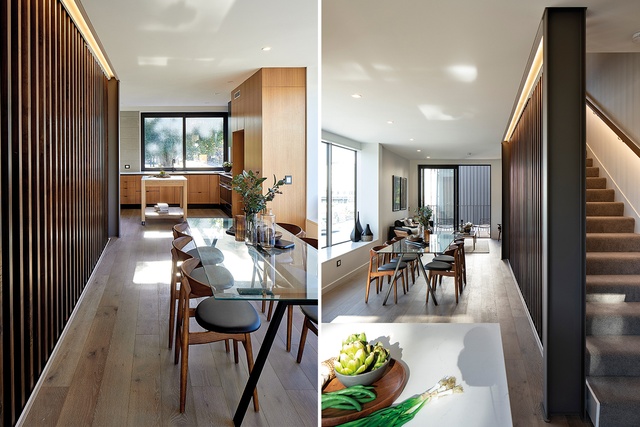
At this price point, value is already seen in city dwelling, especially if it comes with a secure, brand-new pad needing very little maintenance. The building company’s strategy of avoiding ‘buying off a plan,’ but, instead, of building in small steps, re-evaluating and tuning to suit sales, suggests we may not see so many high-end units built on future lots of One Central. This will be an articulation of the market: not redesigning the development as a whole but creating room for more pawn pieces. After all, there is only one queen to each of the eight pawns in a chess set.
Building neighbourhoods to meet current market demand may be most viable economically but there is value in having these upper-market houses and they must be included if Christchurch is to have a vibrant, diverse inner city. The Latimer Terraces have an important role; their offering provides a full set of options to the public. As an anchor project, One Central’s success is linked to the success of Christchurch. The more attractive the city, the more attractive the Latimer Terraces and living in the city will be (and vice versa). Though vibrant in pockets, the cityscape is riddled with blank spaces. Rebuilding a city takes time and, while other anchor projects are grindingly slow in making progress, Christchurch will need to attract people to within its four avenues to truly thrive.
Architecture’s greatest purpose is to serve people and One Central will not be successful until its apartments are lived in, its spaces enjoyed, and its communities and contribution to Christchurch shaped. The Latimer Terraces are ready to fulfil their potential but will the right combination of buyers in this niche come along? For now, these apartments are very elegant pieces on the One Central playing board.
1 Christchurch Central Recovery Plan, July 2012, CERA, Christchurch, New Zealand.
2 Accurate as at January 2020.


